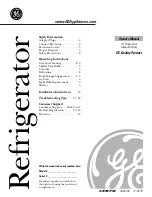
4
Operation
Before use
Remove all securing tapes. Wash inside the
appliance with lukewarm water and bicarbonate of
soda (5 ml to 0.5 litre of water). Do not use soap or
detergent as the smell may linger. Dry thoroughly.
Setting the temperature
The temperature inside the refrigerator is regulated
by a thermostat control knob with 6 temperature
positions and one ÇOFFÈ (O) position.
Position 1 = minimum coldness
Position 6 = maximum coldness
Turn the thermostat control knob to the required
position.
An intermediate position is usually the most suitable,
although the temperature will be affected by:
¥ Room temperature
¥ How often the door is opened
¥ How much food is stored
¥ Position of the appliance
In determining the correct temperature control setting
all these factors have to be considered and some
experimentation may be necessary.
When altering the temperature setting, allow 24
hours for the temperature to stablise before making
further changes.
Important
During prolonged periods of abnormally hot
weather, if the thermostat is set on too high a
number, the cooling system may operate
continuously and the fridge cooling plate may
not defrost. Turning the knob to a lower
number will cause the automatic defrosting to
resume.
Low room t
emperature
s
witch
The appliance is designed to operate in room
temperatures of 16¡C to
38
¡C, or down to 10¡C if the
low room temperature
switch is switched on. The
low
room temperature
switch should be
depressed
when
the room temperature drops below 16¡C (the
incorporated lamp will illuminate). If the room
temperature drops below the above figures the
temperature in the freezer may rise above -18¡C,
then safe storage of frozen food can no longer be
guaranteed.
No damage can be caused by
leaving the switch
in this position for a period of time bu
t energy
will be wasted.
A.
Thermostat dial
B.
Low room temperature
switch
The refrigerator compartment
Fresh food refrigeration
The coldest area of the refrigerator is the lower part,
above the salad bin.
To obtain the best performance, do not store warm
food or evaporating liquids in the refrigerator; do
cover or wrap the food, particularly if it has a strong
flavour.
Do not cover the shelves with any protective
material, such as paper, cardboard or plastic, which
may obstruct the air circulation through them.
To help you use your refrigerator correctly, here are
some more useful hints:
Raw meat
(beef, pork, lamb & chicken or poultry):
wrap in polythene bags and place on top of the salad
bin.
Meat can only be stored safely in this way for one
or two days at the most.
Fruit & vegetables:
these should be thoroughly
cleaned and placed in the bottom salad bin.
Butter & cheese:
these should be placed in special
airtight containers or wrapped in aluminium foil or
polythene bags to exclude as much air as possible.
Milk bottles:
these should have a cap and should be
stored in the bottle rack on the door.
B
A


































